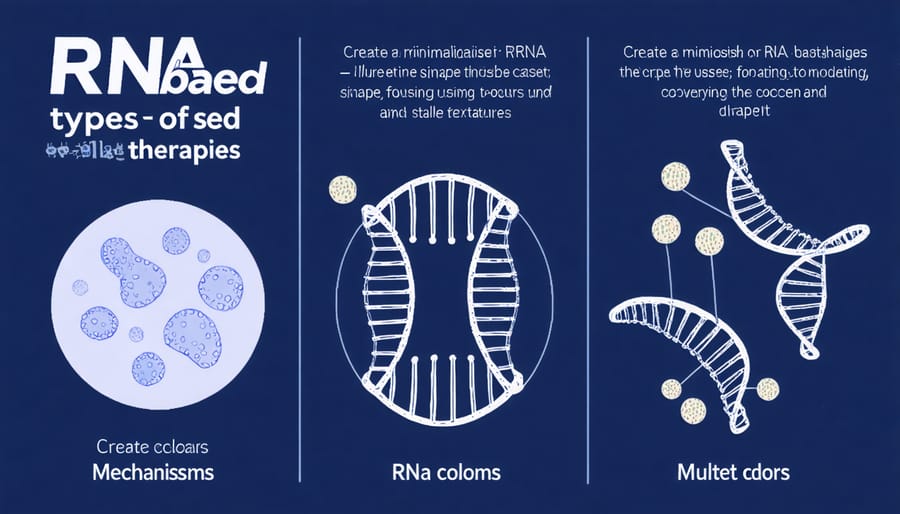RNA-based therapies are revolutionizing medicine by targeting diseases at their genetic core, offering hope for conditions once considered untreatable. Unlike traditional medications that manage symptoms, these innovative treatments work by directly modifying or regulating gene expression, effectively addressing the root cause of genetic disorders. The success of mRNA vaccines during the COVID-19 pandemic has catapulted this field into the spotlight, demonstrating the remarkable potential of RNA technology in healthcare.
Today, scientists are developing RNA therapies for a wide range of conditions, from rare genetic disorders to common diseases like cancer and heart disease. These treatments can silence harmful genes, replace missing proteins, or correct genetic errors with unprecedented precision. Canadian researchers are at the forefront of this medical revolution, working on breakthrough treatments that could transform patient care across the country.
What makes RNA therapies particularly promising is their ability to be rapidly adapted and personalized to individual patients, potentially offering more effective and targeted treatment options with fewer side effects than conventional therapies. As this field continues to advance, it represents one of the most significant developments in modern medicine, offering new hope for patients who previously had limited treatment options.
Understanding RNA-Based Therapies
The Science Behind RNA Medicine
RNA, or ribonucleic acid, plays a vital role in how our genes function and produce proteins essential for our health. Think of RNA as a messenger that carries instructions from our DNA to create the building blocks our bodies need. When genetic diseases occur, it’s often because these messages aren’t being delivered or read correctly.
RNA medicine works by targeting these messaging systems to treat diseases at their genetic source. Scientists can now create synthetic RNA molecules that either replace faulty genetic instructions or help correct errors in the body’s RNA processing. This approach is particularly powerful because it can be precisely tailored to address specific genetic issues.
The breakthrough that made RNA medicines possible came from understanding how to protect these delicate molecules and deliver them to the right cells in our bodies. This led to the development of various RNA-based treatments, including vaccines and therapies for rare genetic conditions.
Unlike traditional medications that typically manage symptoms, RNA medicines can potentially fix the underlying cause of genetic diseases, offering hope for conditions that were previously untreatable.

Types of RNA-Based Treatments
RNA-based treatments come in several forms, each designed to address specific genetic conditions in different ways. The most common type is antisense therapy, which works by blocking harmful genetic messages that cause disease. Think of it like a spell-check tool that catches and corrects genetic mistakes before they can cause problems.
Another important approach is RNA interference (RNAi) therapy, which helps “silence” genes that are causing health issues. This method is particularly useful in treating conditions where certain genes are overactive and causing harm to the body.
Messenger RNA (mRNA) therapies, which gained widespread attention during the COVID-19 pandemic, teach our cells to produce specific proteins that can fight disease or replace missing proteins. This approach has shown promising results in treating various conditions, from rare genetic disorders to certain types of cancer.
Newer developments include RNA editing therapies, which can make precise changes to RNA molecules without altering the underlying DNA, and RNA vaccines, which help prepare our immune system to fight specific diseases.

Current Applications in Genetic Disease Treatment
Success Stories in Rare Disease Treatment
RNA-based therapies have transformed several genetic disease treatment options, offering hope to patients who previously had limited choices. One of the most remarkable success stories is Spinraza, the first approved treatment for spinal muscular atrophy (SMA). This RNA therapy has helped children who were once unable to sit or walk independently achieve significant mobility milestones.
Another breakthrough came with Patisiran, approved in 2018 for treating hereditary transthyretin-mediated amyloidosis (hATTR). This rare but devastating condition affects multiple organs, and patients treated with this RNA therapy have shown marked improvement in their quality of life and disease progression.
Duchenne muscular dystrophy (DMD) patients have also benefited from RNA-based treatments. Eteplirsen helps some patients maintain their ability to walk longer than previously possible by targeting specific genetic mutations responsible for the condition.
The success of these treatments extends to rare eye diseases as well. Luxturna, while not strictly an RNA therapy but related in its genetic approach, has restored functional vision to patients with inherited retinal diseases who were previously facing inevitable blindness.
These achievements highlight how RNA therapies are revolutionizing treatment approaches for rare genetic conditions. Many patients who had no effective treatment options just a decade ago are now living fuller, more active lives. As research continues and more treatments receive approval, the potential for helping patients with rare genetic conditions grows increasingly promising.

Promising Clinical Trials
Several groundbreaking RNA-based therapy trials are currently showing promising results across Canada and worldwide, offering hope for patients with rare genetic conditions and various other health challenges.
One of the most exciting developments is a trial focusing on treating cystic fibrosis using RNA-based delivery systems. Early results suggest improved lung function in participants, with researchers noting better management of symptoms compared to traditional treatments.
Another significant trial involves using RNA therapeutics to address certain forms of muscular dystrophy. The treatment aims to help patients produce essential proteins their bodies currently lack, with initial data showing improved muscle strength in some participants.
Cancer treatment is another area where RNA therapies are showing potential. Several ongoing trials are exploring personalized RNA vaccines that target specific cancer types, with preliminary results indicating stronger immune responses against tumor cells.
Heart disease treatment trials using RNA-based approaches are also underway, focusing on reducing inflammation and promoting tissue repair. These studies have demonstrated promising early results in improving heart function and reducing the risk of future cardiac events.
Additionally, researchers are investigating RNA therapies for neurological conditions, with trials targeting Alzheimer’s disease and Parkinson’s disease showing encouraging initial outcomes. These treatments aim to reduce harmful protein accumulation in the brain and protect nerve cells from damage.
While these trials are still in various stages of development, they represent significant progress in the field of RNA therapeutics and offer hope for more effective, targeted treatments in the future.
Benefits and Advantages
Precision Treatment
RNA-based therapies represent a significant breakthrough in personalized medicine because of their remarkable ability to target specific genetic issues with precision. Unlike traditional treatments that may affect multiple areas of the body, RNA therapies can be designed to work only where they’re needed.
Think of RNA therapy like a highly skilled locksmith who can open one specific lock without affecting any others. These treatments can be custom-made to match the exact genetic sequence that needs correction, whether it’s turning down the production of a harmful protein or replacing a missing one.
This precise targeting means fewer side effects for patients compared to conventional treatments. For example, in treating certain genetic disorders, RNA therapies can focus on correcting the exact genetic message that’s causing the problem, leaving healthy cells untouched.
The precision of RNA therapies is particularly valuable when treating rare genetic conditions. Scientists can design treatments that address the unique genetic makeup of different patient groups, making it possible to help people who previously had limited treatment options.
Recent advances have made it possible to deliver these treatments more effectively to specific tissues and organs. This targeted delivery ensures the therapy reaches exactly where it’s needed in the body, improving its effectiveness while minimizing potential impacts on other areas.
Fewer Side Effects
RNA-based therapies offer a significant advantage over traditional treatments when it comes to side effects. Unlike conventional medications that might affect multiple systems in the body, RNA therapies can be designed to target specific genes or proteins involved in a particular disease process. This precise targeting means fewer unintended effects on healthy cells and tissues.
For example, while traditional chemotherapy affects both healthy and cancerous cells, RNA-based treatments can be engineered to recognize and act only on specific cancer cells. This selective approach typically results in reduced nausea, fatigue, and other common side effects associated with conventional treatments.
The body also naturally processes RNA molecules, making them less likely to accumulate in organs or trigger adverse immune responses. This natural compatibility means patients often experience better tolerance to RNA-based treatments compared to traditional drug therapies.
Many patients report maintaining a better quality of life during treatment, as they can often continue their daily activities with minimal disruption. This improved side effect profile is particularly beneficial for individuals requiring long-term treatment or those who may be sensitive to traditional medications.
However, it’s important to note that while RNA-based therapies generally have fewer side effects, they may still cause some mild reactions, such as injection site responses or temporary flu-like symptoms. These effects are typically manageable and short-lived compared to the more severe side effects of conventional treatments.
What This Means for Canadian Patients
Access to Treatment
Access to RNA-based therapies in Canada varies depending on the specific treatment and its approval status through Health Canada. Currently, several RNA-based medications are available through the public healthcare system, though treatment costs and accessibility can present challenges for some patients.
Most RNA-based treatments require a specialist’s prescription and are typically administered in hospital settings or specialized clinics. Coverage varies by province and territory, with some treatments fully funded through provincial health insurance plans while others may require private insurance or out-of-pocket payment.
Patient support programs are available through pharmaceutical companies and healthcare organizations to help Canadians navigate access to these innovative treatments. These programs can assist with insurance coverage, paperwork, and sometimes even financial support for eligible patients.
For rare genetic conditions, special access programs exist through Health Canada that may provide coverage for RNA-based therapies not yet widely available. Patients are encouraged to discuss these options with their healthcare providers and contact their provincial health authority to understand specific coverage details in their region.
As research continues and more RNA-based treatments receive approval, access is expected to improve across Canada, making these innovative therapies available to more patients who could benefit from them.
Future Developments
Canadian patients can look forward to significant advances in RNA-based therapies over the next few years. Several promising treatments are currently in clinical trials across the country, with some expected to receive Health Canada approval by 2025. These upcoming therapies target a broader range of conditions, including various types of cancer, heart disease, and rare genetic disorders.
Research facilities in Toronto, Vancouver, and Montreal are developing more efficient delivery systems for RNA medications, which could mean fewer doses and reduced side effects for patients. Additionally, new manufacturing techniques are expected to lower treatment costs, potentially making these innovative therapies more accessible to Canadians through provincial health coverage.
Personalized RNA treatments, tailored to individual genetic profiles, are also on the horizon. This advancement could revolutionize how we treat diseases by creating more effective, targeted therapies with fewer complications. Canadian researchers are particularly focused on developing treatments for conditions that affect our northern communities, including specialized formulations that remain stable in remote healthcare settings.
The future also holds promise for preventive RNA medicines, which could help stop diseases before they develop. This approach could be especially valuable for Canadians with family histories of specific genetic conditions. While these developments are exciting, it’s important to remember that new treatments must undergo rigorous testing and approval processes to ensure safety and effectiveness.
RNA-based therapies represent a groundbreaking advancement in modern medicine, offering new hope for treating conditions that were once considered untreatable. As we’ve seen throughout Canada and worldwide, these innovative treatments are already making a significant difference in people’s lives, particularly in treating rare genetic disorders and certain types of cancer.
The future of RNA-based therapies looks incredibly promising. Researchers are currently developing new applications for treating common conditions like heart disease, diabetes, and autoimmune disorders. The success of RNA vaccines during the COVID-19 pandemic has also accelerated research and development in this field, leading to increased funding and public awareness.
For Canadians, access to RNA-based treatments continues to improve as more therapies receive Health Canada approval. While some challenges remain, such as storage requirements and delivery methods, ongoing technological advances are steadily addressing these issues. The cost of these treatments is also expected to decrease as manufacturing processes become more efficient.
As we look ahead, RNA-based therapies are likely to become an increasingly important part of personalized medicine, offering tailored treatments based on individual genetic profiles. This advancement in medical science not only provides hope for patients with previously untreatable conditions but also represents a significant step toward more effective, targeted healthcare solutions for all Canadians.
The continued development of RNA-based therapies stands as a testament to human innovation and scientific progress, promising a healthier future for generations to come.

